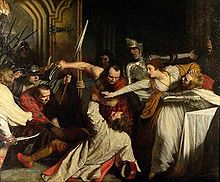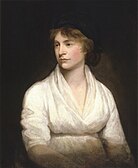John Opie
John Opie PRA (born May 16, 1761 in Trevellas , Cornwall , England, † April 9, 1807 in Westminster , England) was a Cornish history and portrait painter. He painted many eminent men and women of his day, including members of the British Royal Family , artists and writers.
life and work
Opie was born in Trevellas near Truro in Cornwall , England, the youngest of five children of carpenter Edward Opie and his wife Mary (née Tonkin). At a young age he showed a special talent for painting and mathematics. At the age of twelve he mastered Euclid's work and opened an evening school for poor children, where he taught them reading, writing and arithmetic. However, his father did not support Opie in promoting his talents and instead sent him to an apprenticeship in his own trade, carpentry.
Eventually, the local doctor and satirist Dr. John Wolcot (Peter Pindar) noticed Opie's artistic abilities and visited him in the sawmill where he worked in 1775. Wolcot recognized Opie's great talent and became his mentor. He bought him from his apprenticeship and urged him to move to him in Truro. Through Wolcot he received invaluable encouragement, advice, school fees, and practical help in advancing his early career.
In 1781 Opie moved to London with Wolcot after having gained considerable experience as a portraitist on various trips through Cornwall. There they lived together after they had formally reached an agreement on the distribution of the profits from the painting. Although Opie von Wolcot received extensive artistic training, the doctor decided to portray him as a self-taught child prodigy; The portrait of a boy shown in the Society of Artists the previous year was described in a catalog as "an example of a genius such as a painting has never seen". Wolcot introduced the "Cornish miracle" to potential cartridges and leading artists, including Sir Joshua Reynolds , who compared Opie to Caravaggio and Velázquez . The business agreement between Wolcot and Opie was limited to one year. after which Opie let his mentor know that he wanted to go his own way, which led to the estrangement of the two former partners.
Wolcot had succeeded in introducing Opie to court through the influence of a certain Mrs. Boscawen. King George III acquired one of his paintings and commissioned a portrait of Mary Delany . Opie also received commissions for paintings by the Duchess and Duke of Gloucester , Lady Salisbury, Lady Charlotte Talbot, Lady Harcourt, and other ladies-in-waiting. Opie's home at "Orange Court" on Castle Street in Leicester Square was said to be "full of name every day" and the subject of urban gossip. In 1782 he exhibited for the first time at the Royal Academy of Arts , and in December of that year he married Mary Bunn. The union, however, proved an unfortunate one and was eventually divorced in 1796 after Mary ran away.

After an initial storm of enthusiasm, Opie's works quickly went out of fashion. In response, he began to work on improving his technique, while at the same time striving to supplement his earlier education with studying Latin, French, and English literature, and polishing up his provincial manners by seeking cultured and learned circles. In 1786 he showed his first significant historical work, the assassination attempt on James I and in the following year the murder of Rizzio , a work whose importance was honored by Opie's immediately following election as associate of the Royal Academy. Two years later he became a full member of the Academy. He painted five scenes for John Boydell's Shakespeare Gallery; until his death, Opie varied between portraits and historical scenes. In May 1798 he married Amelia Alderson , whom he had met at a party in Norfolk when he was doing work for Thomas Coke at Holkham Hall . They lived together at 8 Berners Street, where Opie had moved in 1791.
Opie painted many important personalities, including Mary Wollstonecraft , Samuel Johnson , Francesco Bartolozzi , John Bannister, Joseph Shepherd Munden, Charles James Fox , Edmund Burke , John Crome, James Northcote, Henry Fuseli , Thomas Girtin , Robert Southey , Samuel Parr, Elizabeth Inchbald and Mary Shelley ; a total of 508 paintings, most of them in oil and 252 of other qualities.
Teaching and writing
In 1805 Opie was appointed professor at the Royal Academy and held a series of four lectures from May 1806, which were published as a book after his death in 1809 together with memoirs by his widow Amelie Opie. One of his students at the Academy was Henry Thomson . Opie was also an art writer through his contribution The Life of Reynolds to Wolcot's edition of Matthew Pilkington's Dictionary of Painters and his letter on the cultivation of the fine arts in England advocating the establishment of a national gallery.
death
Opie died in April 1807 at the age of 46 in his home on Berners Street and was buried in St Paul's Cathedral in the crypt next to Joshua Reynolds , as he had wished.
- John Opie's painting
Philip Beaver , ca.1805
Individual evidence
- ↑ Viv Hendra: The Cornish Wonder, A Portrait of John Opie . Truran, Truro 2007, ISBN 978-1-85022-216-3 , pp. 3, 165 (English).
- ↑ a b Earland, Ada. John Opie and his circle (London: Hutchinson & co., 1911)
- ↑ Rogers, 1878, pp. 10-14
- ↑ a b c d e f g h i j Opie, John in Encyclopædia Britannica , 11th edition 1911.
- ↑ Earland 1911, p. 26
- ↑ Earland 1911, pp. 20-1
- ↑ Earland 1911, p. 12
- ↑ Earland 1911, p. 26: A "Master Oppy" is given as the artist .
- ^ A b c d e f g Opie, John in Dictionary of National Biography , London: Smith, Elder & Co. 1885–1900. Pp. 230-233
- ↑ Earland 1911, pp. 31-2
- ↑ Earland 1911, p. 50
- ↑ Earland, 1911, p. 124.
- ↑ Dr. Samuel Johnson (Philip Mold Fine Paintings).
- ^ Portrait of F. Bartolozzi (National Portrait Gallery, London).
- ↑ Portrait of JS Munden (National Portrait Gallery).
- ↑ Charles James Fox (Philip Mold Fine Paintings).
- ^ Opie, John Lectures on painting, delivered at the Royal Academy of Arts (London, Longman, Hurst, Rees and Orme, 1809).
- ↑ Viv Hendra: The Cornish Wonder - A Portrait of John Opie . Truran, Truro 2007, ISBN 978-1-85022-216-3 , pp. 173 .
literature
A complete list of the exhibited works, the private commissions etc. John Opies can be found in Ada Earland's book "John Opie and his circle" (1911, p. 251 ff.).
- Edwards, BB & Bulfinch, SG Biography of self-taught men: with an introductory essay (Boston: JE Tilton and company, 1859) pp. 191-201.
- Tregellas, Walter Hawken. Cornish worthies: sketches of some eminent Cornish men and families, volume 2 (London: E. Stock, 1884) pp. 243-278.
- Rogers, John Jope . Opie and his works (London: P. and D. Colnaghi and co. Etc., 1878).
Web links
- Profile at the collection of the Royal Academy of Arts
- John Opie at Artcyclopedia
- The Cornish wonder: John Opie RA (Official website of Viv Hendra's book of the same name)
- John Opie at Artnet
| personal data | |
|---|---|
| SURNAME | Opie, John |
| BRIEF DESCRIPTION | English painter |
| DATE OF BIRTH | May 16, 1761 |
| PLACE OF BIRTH | Trevellas |
| DATE OF DEATH | April 9, 1807 |
| Place of death | Westminster |






